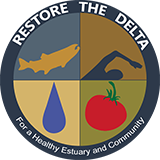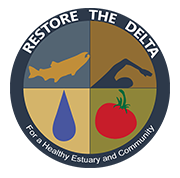Delta Tunnel EIR Released, Restore the Delta Reax – Restore the Delta 12/8/23
SACRAMENTO – Today, the California Department of Water Resources (DWR) released a final Environmental Impact Report (EIR) for Governor Gavin Newsom’s proposed Delta Conveyance Project (Delta Tunnel).
Newsom administration advances Delta Tunnel project despite environmental opposition – Los Angeles Times 12/9/23
Newsom’s tunnel proposal, as outlined in the state’s final environmental impact report, is “another failure of state water officials to imagine alternative approaches in a climate-impacted California,” said Barbara Barrigan-Parrilla, executive director of the group Restore the Delta.
“The big pipe engineering solutions of the last century are no longer the way forward in California water’s climate-changed reality,” Barrigan-Parrilla said. The latest Delta Tunnel plan, she said, is “out of date for climate change science” and will quickly be obsolete if it’s built.
She suggested the state invest in projects that “reduce reliance on water exports from the Delta,” such as underground water storage in farming areas, more stormwater collection and wastewater recycling in cities.
California’s final report on disputed Delta Tunnel project shows fish and farms still at risk – Sacramento Bee 12/8/23
California’s water agency released a final report Friday on the controversial plan to build a tunnel beneath the Sacramento-San Joaquin River Delta. The highly anticipated document is expected to lead to approval of the water project.
The environmental impact report said the tunnel’s construction and operations would significantly impact the Delta’s endangered and threatened fish species, tracts of important regional farmland and tribal cultural resources that include human remains…
“Governor Newsom’s proposed Delta tunnel, as outlined in this new EIR, is another failure of state water officials to imagine alternative approaches in a climate-impacted California,” said Barbara Barrigan-Parrilla, executive director of Restore the Delta. “This is sadly just another zombie version of the Peripheral Canal idea that was rejected by California voters way back in 1982. And DWR seems to have learned nothing since California Governor Brown’s Twin Tunnel (WaterFix) died in 2019.”
What’s up with the Delta Tunnel(s)? – Politico 12/8/23
But behind-the-scenes, Newsom has been “full-throated” in supporting the Delta conveyance, said Anthony York, the governor’s spokesperson.
“Every opportunity he’s had, he’s been an outspoken supporter,” York said. “He’s been clear on a lot of these projects he wants them to go faster, whether you’re talking about conveyance or Sites or bringing our clean energy projects online.”
Environmental groups haven’t budged much and stand ready to fight in court. Barbara Barrigan-Parrilla, the executive director of Restore the Delta, said she was disappointed the governor hasn’t yet come up with a final plan to protect flows in the Delta long-term.
“There was hope, when he came in with this administration, that there would be broad consensus building work between environmental groups and water districts and water agencies, and now I would say it’s more polarized than ever,” she said.
Delta Tunnel EIR Criticized – Vic Bedoian, KPFA 12/9/23
The California department of water resources today released the final environmental impact report for the controversial Delta Tunnel. It takes state one step closer to building a conveyance that would funnel fresh water flows from the Sacramento River under the Delta at the rate of 6000 cubic feet per second. Bay-Delta advocates reacted harshly to the action. Vic Bedoian reports from Fresno.
Environmental and fish groups slam final Delta Tunnel EIR as California fish populations collapse – Dan Bacher, Daily Kos 12/8/23
“What is new is the claim that Newsom’s Tunnel is a climate project. But that argument is built on incomplete data and faulty analysis. The big pipe engineering solutions of the last century are no longer the way forward in California water’s climate-changed reality. We need more underground storage in agricultural regions and more regional stormwater collection and water recycling in our cities. The new Delta Tunnel plan was out of date for climate change science when it was released in July 2022. If completed in 2040 it will be obsolete then too,” she continued.
Meanwhile, California will have spent billions on a project the state will be unable to use as Delta water levels rise or when fish need that water for survival during drought years,” Barrigan-Parrilla stated. “Instead, we should invest in the resilience projects that reduce reliance on water exports from the Delta. Southern California has been leading the way with projects that increase efficiency, water recycling, and increase local self-sufficiency.”
A Much Better Water Fix!
L.A. County aims to collect billions more gallons of local water by 2045 – Los Angeles Times 12/6/23
Over the next two decades, Los Angeles County will collect billions more gallons in water from local sources, especially storm and reclaimed water, shifting from its reliance on other region’s water supplies as the effects of climate change make such efforts less reliable and more expensive.
The L.A. County Board of Supervisors on Tuesday adopted the county’s first water plan, which outlines how America’s largest county must stop importing 60% of its water and pivot over the next two decades to sourcing 80% of its water locally by 2045.
The plan calls for increasing local water supply by 580,000 acre-feet per year by 2045 through more effective stormwater capture, water recycling and conservation. The increase would be roughly equivalent to 162 billion gallons, or enough water for 5 million additional county residents, county leaders said.
“We need to conserve every drop of water possible for beneficial reuse by reducing demand, by recycling our water, by capturing much more stormwater in our natural aquifers. And I know that the public is watching to make sure we do exactly that,” said Board Chair Lindsey P. Horvath.
…The plan will focus on a number of goals: improving the reliability of the region’s water supply; collecting and storing groundwater; increasing the quality and resilience of small systems that are at risk of failing; mitigating the impact of wildfires on the water supply and managing watershed sediment.

